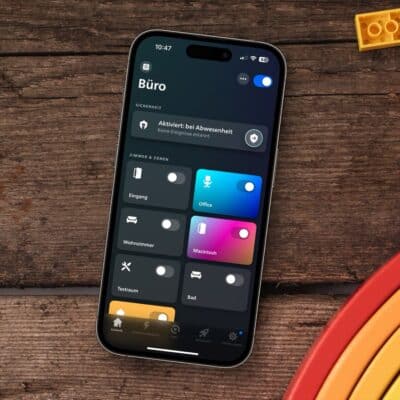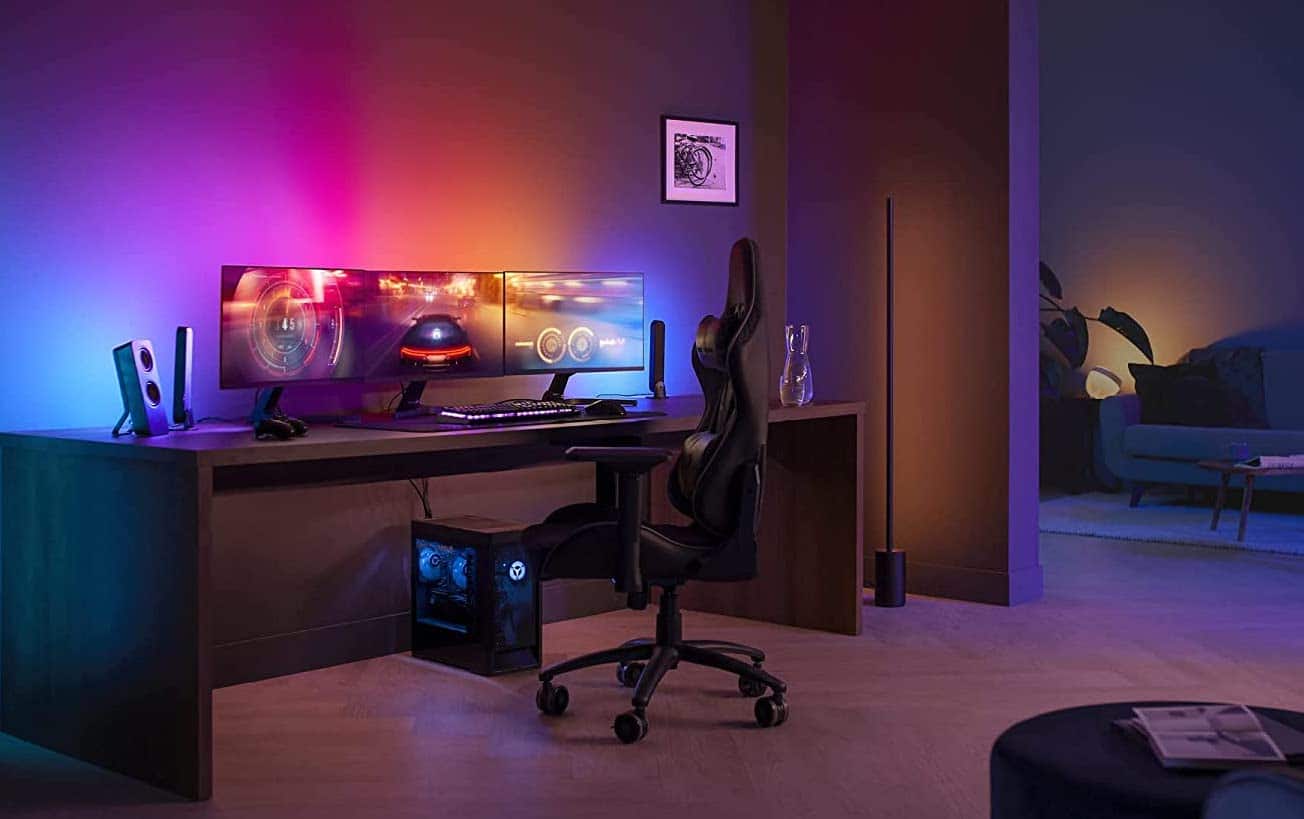When it was announced at the beginning of August that Philips Hue would probably offer its Play Gradient Lightstrip for PC monitors with 24 to 27 inches, the outcry was great. The community immediately complained that especially in the gaming sector, most users probably prefer larger screens.
Now I can tell you: don’t worry. Philips Hue has thought along. And it has done so twice. First of all, in addition to the Philips Hue Play Gradient Lightstrip for monitors with a diagonal of 24 to 27 inches, there will also be a slightly longer version for screens with 32 to 34 inches.
But that is not all. As I was now able to find out, Philips Hue will also offer a solution for multi-display setups – more precisely for desks with three displays of 24 to 27 inches standing next to each other. The solution: the not necessarily very flexible light strip is interrupted between the monitors.
So it is not simply a matter of two light strips connected to each other, but of specially adapted individual parts that are then apparently firmly connected to each other with a cable. The small gaps on the back of the monitors should have no real influence on the illumination of the background.
And I can already tell you the list prices for the light strips. Here is a small overview:
- Philips Hue Play Gradient Lightstrip 24 – 27 inch for 149,99 Euro
- Philips Hue Play Gradient Lightstrip 32 – 34 inch for 169,99 Euro
- Philips Hue Play Gradient Lightstrip 24 – 27 inch Multi-Monitor-Setup for 259,99 Euro
It remains to be seen when exactly the official announcement will be made and when the new products will launch.
Philips Hue Play Gradient Lightstrip PC
from $169.99 / £129.99 / €149,99
Note: This article contains affiliate links. We receive a commission for purchases via these links, which we use to finance this blog. The purchase price remains unchanged for you.
































I’m looking at getting a 2nd 49 inch ultrawide to stack ontop of my existing.. that would make it 1200mm x 672mm (54inch diag)… is it true you can use the standard gradient light strip and connect to philips hue app and not require the hdmi sync box?
@Mike
I don’t have a Hue Sync box, so I’m not sure if all the features are the same, but the entertainment area configuration is the same, and both the app and the Sync Box basically just take the colors of the screen and streams the corresponding colors to the lights configured in the corresponding entertainment area according to their 3D localization (configured in the mobile app), so I suspect the result is exactly the same.
The thing to remember when planning an entertainment area is that lights sources are localized in 3D space, bulbs are points, and lightstrips are straight bars that can be parallel, perpendicular, or vertical.
This means if you bend a lightstrip (or separate it into segments with 3rd party extension connectors and cables), the system will not let you orient these segments as separate bars in 3D space, it will stay as a single straight bar and you’ll have to compromise the colors locations for some segments.
The Lightstrip Hue Play Gradients designed to mount behind a screen are an exception, they cannot be localized in 3D and will always be assumed to be behind the screen, but they’ll be handled as 3 separate segments properly aligned with the top and both sides of the screen. I suppose the upcoming lightstrips for monitors will behave the same.
You could setup a standard Gradient Lightstrip horizontally behind your ultrawide monitor, but it will be synchronized as a horizontal bar. If you bend some of it for the sides, it will not handle the sides separately like the upcoming strips would do.
As far as I know, if you really want to have the two sides properly sync with the colors on the side of the screens, you’ll need two other light sources to handle the sides separately, for example two extra Gradient Lightstrips cut to shorter lengths, or two Hue Gradient Signe.
I’m not sure the Sync Box would play well with non-16:9 resolutions, and even if it did, you’d probably need two Sync Boxes and two entertainment areas with separate individual lights to cover 2 monitors.
The Sync app on the other hand supports multi-monitor setups (tested on Windows, not sure about Mac), you can select which monitors are part of the sync setup. This makes it possible for example to have three monitors for your field of view that the lights synchronize to, but exclude a smaller monitor you keep on the side for IM, streaming, …